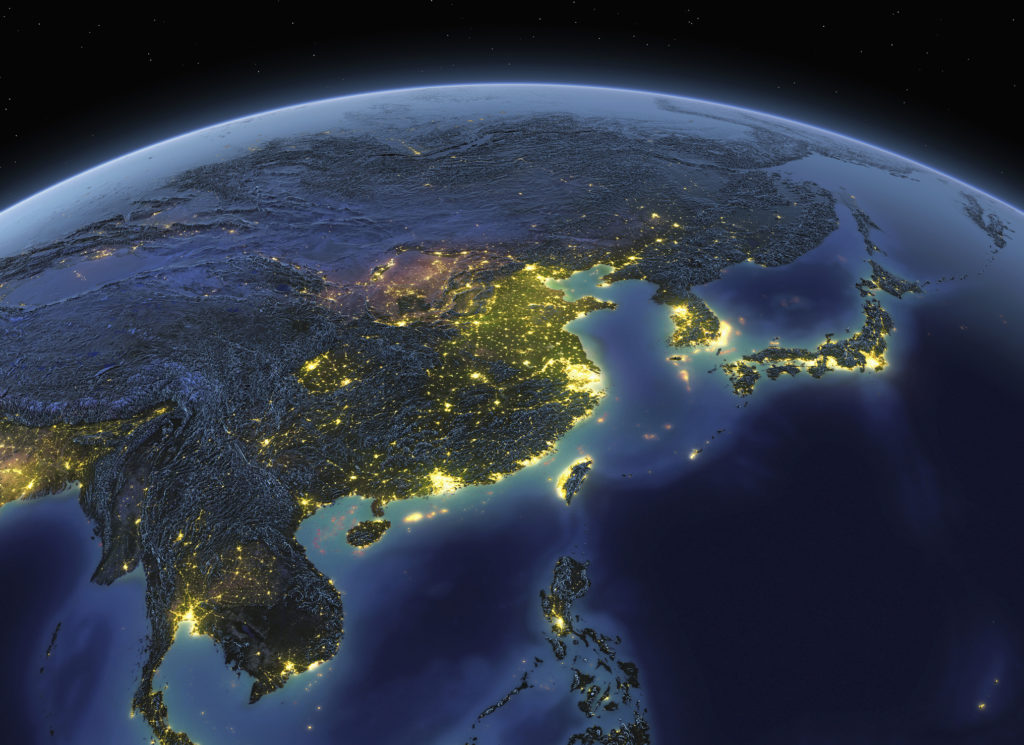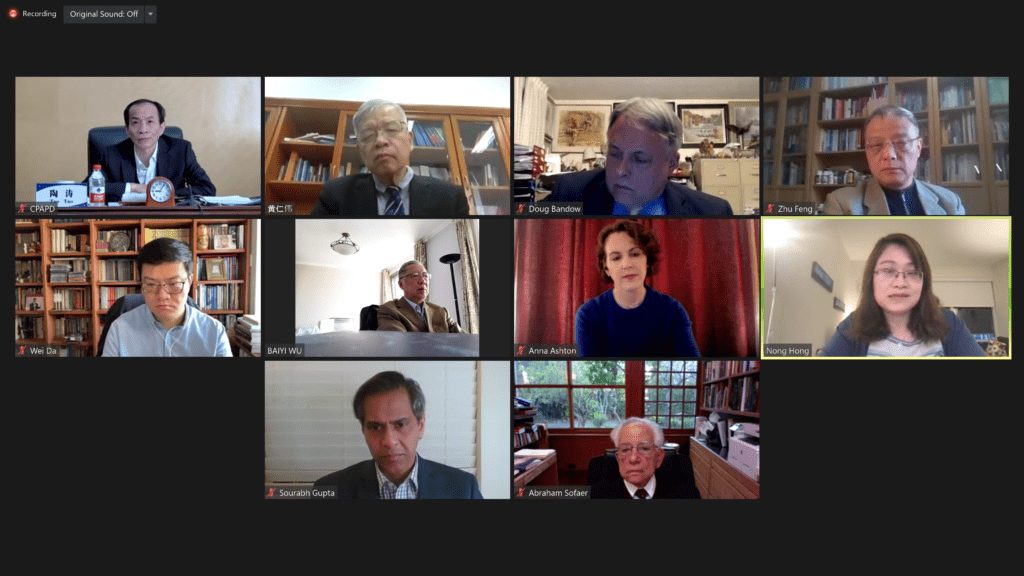
ICAS Bulletin (online ISSN 2836-3418, print ISSN 2836-340X) is published every other week throughout the year at 1919 M St NW, Suite 310, Washington, DC 20036.
The online version of ICAS Bulletin can be found at chinaus-icas.org/bulletins/.

– On February 27, the White House called on China to explicitly condemn Russia’s invasion of Ukraine.
– On February 26, Chinese Foreign Minister Wang Yi spoke on the phone to several European leaders, where he emphasized the need for restraint amid Russia’s escalation of the conflict and ensuing humanitarian crisis in Ukraine.
– On February 25, China abstained from voting on a UNSC draft resolution, ultimately vetoed by Russia, that would have condemned Russia’s invasion of Ukraine.
– On February 25, Chinese President Xi Jinping told Russian President Vladimir Putin on the phone to pursue negotiations with Ukraine and end the war.
– On February 25, Wang Yi spoke to Russian Foreign Minister Sergei Lavrov, telling him that China respects both Ukraine’s sovereignty and Russia’s security concerns.
– On February 25, it was reported that U.S. officials repeatedly presented intelligence of Russia’s troop buildup around Ukraine to their Chinese counterparts for months leading up to the invasion, imploring them to persuade Russia not to invade. Chinese officials reportedly passed on the intelligence with Moscow.
– On February 24, following Russia’s recognition of the Donetsk and Luhansk breakaway republics and subsequent invasion of Ukraine, Wang Yi urged “all parties” to “exercise restraint.”
Associated News References:
“White House calls on China to condemn Russia’s invasion of Ukraine,” Reuters, February 27 [Paywall]
“China Distances Itself From Russia, Calls for Halt to Violence,” Bloomberg, February 26 [Paywall]
“Russia vetoes U.N. Security action on Ukraine as China abstains,” Reuters, February 25 [Paywall]
“China lays out 5-point position on Russia’s invasion of Ukraine,” Axios, February 25
“China’s Xi Urges Putin to Negotiate With Ukraine During Call,” Bloomberg, February 25 [Paywall]
“In phone call, China plays a balancing act over Russia’s invasion of Ukraine,” NPR, February 25
“U.S. Officials Repeatedly Urged China to Help Avert War in Ukraine,” The New York Times, February 25 [Paywall]
“China seeks action to end rising Ukraine crisis as Putin gives order for military operation,” South China Morning Post, February 24 [Paywall]

– On March 1, it was reported that Chinese petroleum and coal purchases from Russia fell dramatically following Russia’s invasion of Ukraine with many importers wary of sanctions and unable to obtain lines of credit.
– On February 26, it was reported that China and Russia have been deepening their economic ties over the past year, most recently with a multiannual oil deal worth over $20 billion signed just two weeks ago.
– On February 25, two of China’s largest state-owned banks stopped issuing dollar-denominated lines of credit for the purchase of Russian commodities.
– On February 25, as several Western leaders debated different ways to sanction Russia, some experts speculated that China would benefit from cutting Russia off from the SWIFT payment system as China’s Cross-Border Inter-Bank Payments System (CIPS) could fill the void for ruble transactions.
– On February 27, India also published a report which questioned the sustainability of SWIFT and recommended that the local SFMS system be improved.
– On February 24, it was reported that China is ready to soften the impact of punitive sanctions on Russia for the invasion of Ukraine after MFA Spokesperson Hua Chunying underscored China’s opposition to “illegal unilateral sanctions” in her daily remarks.
Associated News References:
“China’s Russian coal purchases stall as buyers struggle to secure financing,” Reuters, March 1 [Paywall]
“West cuts Russia off SWIFT, India and China explores alternatives,” The Tribune, February 27
“Before Ukraine Invasion, Russia and China Cemented Economic Ties,” The New York Times, February 26 [Paywall]
“China State Banks Restrict Financing for Russian Commodities,” Bloomberg, February 25 [Paywall]
“China Pausing on Buying Russian Seaborne Crude After Invasion,” Bloomberg, February 25 [Paywall]
“U.S., Allies Roll Out Fresh Sanctions on Russia Amid Debate Over How Hard to Hit,” The Wall Street Journal, February 25 [Paywall]
“China ready to soften economic blow to Russia from Ukraine sanctions,” Financial Times, February 24 [Paywall]

– On March 1, TikTok—a subsidiary of Chinese company ByteDance—and Youtube joined Meta Platforms in restricting access to Russian state media accounts to users in the European Union.
– On February 25, Chinese social media was divided over the Ukraine war. Several Weibo users applauded Russia’s invasion—Vladimir Putin’s boldness as a leader in particular—while others hoped for a return to peace and urged greater empathy with the plight of Ukrainians.
– On February 23, China’s Ministry of Foreign Affairs spokesperson Hua Chunying accused the U.S. of “creating fear and panic” in Ukraine by providing diplomatic and materiel support to Kyiv. Following Russia’s invasion on the 24th, Hua urged all parties to “go back to dialogue and negotiation” and questioned Washington’s diplomatic efforts saying “the U.S. has been… fanning up the flame, how do they want to put out the fire?”
– On February 22, the Chinese embassy in Ukraine issued a warning to its nationals there to “strengthen security precautions,” but Beijing broke with much of the rest of the world by not calling for its citizens to evacuate.
– On February 20, amid increasingly credible reports of a forthcoming Russian invasion of Ukraine, Wang Yi spoke at the Munich Security Conference and said that “Ukraine is no exception” to the principles of “sovereignty, independence and territorial integrity.”
Associated News References:
“TikTok Joins Meta in Restricting Access to Russian State Media,” The Wall Street Journal, March 1 [Paywall]
“China’s netizens split on Ukraine war as crude joke sparks anger,” Nikkei Asia, February 25 [Paywall]
“China refuses to call Russian attack on Ukraine an ‘invasion,’ deflects blame to U.S.,” CNBC, February 24
“China says US creating ‘fear and panic’ over Ukraine,” ABC News, February 23
“China concerned about ‘worsening’ Ukraine situation, warns nationals there,” Reuters, February 22 [Paywall]
“‘Ukraine no exception’: China stresses sovereign rights for all nations,” South China Morning Post, February 20 [Paywall]

– On March 1, President Biden delivered his first State of the Union address, where he discussed Ukraine, results of the administration’s economic strategy and an economic vision to invest and educate in America.
– On February 24, the White House announced a 10-step plan to enhance the security of U.S. supply chains against climate shocks, extreme weather events as well as geopolitical and economic competition.
– On February 23, the Justice Department revealed that it is terminating the China Initiative, a program initiated by the Trump administration to target Beijing for alleged theft of intellectual property rights.
– On February 17, the U.S. trade representative (USTR)’s office added two Chinese e-commerce platforms, AliExpress and WeChat e-commerce, to the office’s annual “notorious markets” list, alleging their contribution to the sale of counterfeit goods and corresponding IP rights violation.
– On February 17, U.S. diplomats confirmed that the U.S. will not engage with China in the Biden administration’s proposed Indo-Pacific Economic Framework.
– On February 16, the USTR office said past U.S. engagements under the WTO framework have been ineffective in changing China’s “harmful,” “non-market” trade practices, calling for new strategies and new tools.
Associated News References:
“Remarks of President Joe Biden – State of the Union Address As Prepared for Delivery,” The White House, March 1
“FACT SHEET: Background on President Biden’s Remarks on the Economy During His First State of The Union Address,” The White House, February 28
“White House unveils more steps to strengthen U.S. supply chains,” Reuters, February 24 [Paywall]
“The Justice Department is ending its controversial China Initiative,” NPR, February 23
“Alibaba, Tencent E-Commerce Sites Tagged by U.S. for Counterfeit Sales,” The Wall Street Journal, February 18 [Paywall]
“U.S. has ‘no intention’ to engage with China on Indo Pacific Economic Framework,” Reuters, February 17 [Paywall]
“U.S. says China’s aggressive trade policies ’cause serious harm’,” PBS, February 16 [Paywall]
“Biden to seek more than $770 billion in 2023 defense budget, sources say,” Reuters, February 16 [Paywall]

– On February 28, the Biden administration sent an unofficial delegation of former U.S. officials to Taiwan to reaffirm U.S. commitments. Calling the delegation a “vain” attempt, China urged the U.S. to abide by the one-China principle and stop official interactions with Taiwan.
– On February 27, former Japanese Prime Minister Abe Shinzo called on the U.S. to abandon strategic ambiguity and make it certain that it will defend Taiwan.
– On February 26, the U.S. Navy said a U.S. warship sailed through Taiwan Strait as part of a “routine” transit through international waters.
– On February 23, in response to Britain’s concern over the global implications of the Ukraine crisis such as on Taiwan, China’s Foreign ministry spokesperson Hua Chunying stressed that “Taiwan is not Ukraine” and has “always been an inalienable part of China.”
– On February 23, Taiwan President Tsai Ing-wen asked “all government units” to be more vigilant amid the “morale” impact of the Ukraine crisis.
Associated News References:
“U.S. delegation arrives in Taiwan as China denounces visit,” Reuters, March 1 [Paywall]
“Biden sending delegation to Taiwan to reaffirm commitment amid Russia’s invasion of Ukraine,” The Washington Post, February 28 [Paywall]
“U.S. should abandon ambiguity on Taiwan defense: Japan’s Abe,” Nikkei Asia, February 27 [Paywall]
“US warship transits sensitive Taiwan Strait in first such sailing for 2022,” South China Morning Post, February 26 [Paywall]
“Beijing says Taiwan is ‘not Ukraine,’ has always been part of China,” The Hill, February 23
“Wary of China, Taiwan calls for vigilance amid Ukraine escalation,” Deutsche Welle, February 23
“Taiwan, eyeing parallels to Ukraine, condemns Russian invasion,” The New York Times, February 23 [Paywall]
“China sanctions US defence firms Raytheon, Lockheed over Taiwan,” Al Jazeera, February 21

“China willing to work with U.S. on Build Back Better World initiative,” Reuters, February 28 [Paywall]
“New Research Points to Wuhan Market as Pandemic Origin,” The New York Times, February 26 [Paywall]
“Bitcoin less green since China ban, research suggests,” BBC, February 25
“COMPACFLT Paparo: U.S., Japan Joint Naval Operations Key to Pacific Security,” USNI News, February 17
“Xi-Macron talks show China seeking French route to better EU ties,” South China Morning Post, February 17 [Paywall]
“Australia and UK deepen security ties amid China worries,” Al Jazeera, February 17
February 23 hosted by Pacific Forum
February 24 hosted by Brookings
February 28 hosted by German Marshall Fund
February 28 hosted by Wilson Center
February 28 hosted by Atlantic Council
March 3-4 hosted by The Center for Innovation Policy at Duke Law
March 9 hosted by SupChina
March 10 hosted by East-West Center
March 18 hosted by Redefining Hong Kong
When Data Universes Collide: U.S. and China’s Rival Approaches to Data-linked Decoupling
Wednesday, March 2, 2022
9:30am – 10:50am EDT
Data is the lifeblood of the digital economy. It is also an arena of fierce maneuvering as China and the United States seek to gain a leg-up in key industries that will define the Fourth Industrial Revolution. President Xi Jinping has emphasized the need to deepen the integration of the Internet, big data and artificial intelligence with the real economy, and in just the past few months a number of important regulations have been issued. These include: (a) a revised cybersecurity regulation for network platform operators (stemming from the Didi Chuxing IPO debacle), (b) proposed security assessment rules for cross-border data export, and (c) proposed unified network data security regulations to implement China’s Data Security Law (DSL), Personal Information Protection Law (PIPL) and Cybersecurity Law. For his part, President Biden issued an executive order in June 2021 on protecting Americans’ sensitive data from foreign adversaries, and the Commerce Department followed up in November 2021 with a proposed rule that could well lead to platforms like TikTok being subjected to third-party auditing and monitoring of user data logs. Earlier, the Trump administration’s Treasury Department had enumerated ten categories of sensitive personal data to be placed beyond the reach of foreign adversaries. What are the drivers behind the U.S. and China’s divergent approaches on data sovereignty? What are the key takeaways from these rules and regulations? Who are the key players involved? What are the investment implications for entrepreneurs and investors on both sides? And as the two sides seek to influence the Indo-Pacific’s cross-border data flow rules and standards, what are the implications of their increasingly mutually decoupled data universes for regional partners as well as for realizing a region-wide digital trade agreement?
Drawing Wisdom from History – An Online Dialogue on US-China Relations, in Commemoration of the 50th Anniversary of President Nixon’s Visit to China
Wednesday, February 23, 2022
8:00-10:30pm EST
On February 23, 2022, Institute for China-America Studies and Chinese People’s Association for Peace and Disarmament jointly held an online dialogue to commemorate the 50th anniversary of President Nixon’s visit to China.
The event featured two panels: Panel I reflected on the historical meaning and strategic value of President Nixon’s visit, while Panel II drew from the insights and experience of the past to find enlightenment for the future development of China-US relations.
Read the general summary of the Chatham House Rules event.

By Dr. Nong Hong
March 1, 2022
Although not an Arctic state, China has called itself a “near-Arctic state” and is an observer in the Arctic Council. It takes an interest in Arctic affairs and the development of Arctic shipping routes such as the Northern Sea Route which could see transits between Europe and Asia shortened if they become commercially viable in the future. While China-Russia ties look to be getting ever closer, Hong Nong explains why close cooperation between the two countries in the Arctic — which some call the theatre of a new Cold War — is not at all straightforward.
The activities of states from outside the Arctic region, such as Arctic Council observers including China, have been challenging the exclusivity of Arctic governance for some time.
China’s presence in the Arctic region ranges from joining international institutions, promoting bilateral diplomacy in the Arctic area and accessing potential resources to exploiting shipping opportunities and undertaking polar research…
This article first appeared on ThinkChina on March 1, 2022.
By Sourabh Gupta
February 28, 2022
On 28 February 1972, the United States and China issued the Shanghai Communique. The document marks a pivotal moment in the history of China’s modern international relations, comparable to its historical treaties at Nerchinsk, Nanjing and Shimonoseki. In Nerchinsk (1689), China’s Qing rulers placed relations with Russia beyond the framework of the tributary system and treated it as a sovereign equal. Nanjing (1842) inaugurated the ‘unequal treaty’ era of extraterritorial rights and merchant autonomy. In Shimonoseki (1895), sovereign Chinese territory (Taiwan) was forcibly ceded to Japan. Coming full circle, the Shanghai Communique — and the earlier October 1949 proclamation of the establishment of the People’s Republic — presaged the ‘fourth rise’ of China, its fuller re-engagement with international society, and the remarkable decades of ‘reform and opening up’.
For the United States, the fundamental strategic calculus that underpinned the China rapprochement was that if Moscow and Beijing were more afraid of each other than they were of Washington, that would present an unprecedented opportunity for American Cold War diplomacy. Improved US–China relations became the key to the Nixon administration’s strategy to modify Soviet conduct. For China, the calculus was simpler: to deny Moscow the attempt to geopolitically encircle China and dominate continental Asia. ‘The small issue is Taiwan; the big issue is the world,’ as Mao confided to Nixon…
This op-ed was originally published on East-Asia Forum on February 28, 2022.
To our readers,
The team at ICAS is proud to present the newly developed ICAS Maritime Affairs Program (MAP) Handbill! The MAP Handbill is a monthly newsletter that highlights the major news stories, research products, analyses, and events occurring in and regarding the maritime domain across the past month.
The first and largest section of the Handbill compiles and summarizes major ‘Recent News in Global Maritime Affairs’, organized into four topics:
The second section of the Handbill is a collection of major ‘Peer-Reviewed Research on Maritime Issues.’ This includes but is not limited to major government releases, expert opinions, and detailed analyses on current issues in global maritime affairs; especially issues that involve the United States and/or China.
The third section of the Handbill lists recent and upcoming ‘Events on the Maritime Domain’ for our readers’ awareness and potential interest; especially events that may involve U.S.-China relations.
The fourth section of the Handbill, the ‘Handbill Spotlight’, is a short-form written background and analysis of a specific issue related to maritime affairs. The topic changes with every issue and can be a general concept (UNCLOS, FONOPs, etc.), a specific location (Guam, Djibouti, the Malacca Strait, etc.), or a particular tool (F-35C, ballistic missile, USS 7th Fleet, etc.). The goal of the Spotlight is to help our readers quickly and accurately understand the basic background of a vital topic in maritime affairs and how that topic relates to what is currently happening today.
The fifth and final section of the Handbill highlights the new and upcoming activity in the ICAS Maritime Affairs Program from the last month. This can include announcements of new interactive maritime issue tracker maps, upcoming events and event summaries, newly published expert issue briefs and commentaries, and maritime-related media appearances by our ICAS team.
With that, the ICAS Team is excited to share with you the first issue of the ICAS MAP Handbill! We hope that this product will help our readers keep aware of important activity in global maritime affairs, especially as they might relate to the United States and China, and fuel our readers’ knowledge to better navigate the vital and complex environment that makes up the maritime domain.
Kind regards,
Jessica Martin – Chief Editor, ICAS MAP Handbill
On Monday, February 28, 2022, Senior Fellow Sourabh Gupta shared his outlook on the upcoming Two Sessions meeting with China Daily.
On Sunday, February 20, 2022, Senior Fellow Sourabh Gupta was quoted by The Global Times on the success of the Beijing Winter Olympic Games.

The Institute for China-America Studies is an independent nonprofit, nonpartisan research organization dedicated to strengthening the understanding of U.S.-China relations through expert analysis and practical policy solutions.
1919 M St. NW Suite 310,
Washington, DC 20036
icas@chinaus-icas.org
(202) 968-0595
© 2025 INSTITUTE FOR CHINA-AMERICA STUDIES. ALL RIGHTS RESERVED.